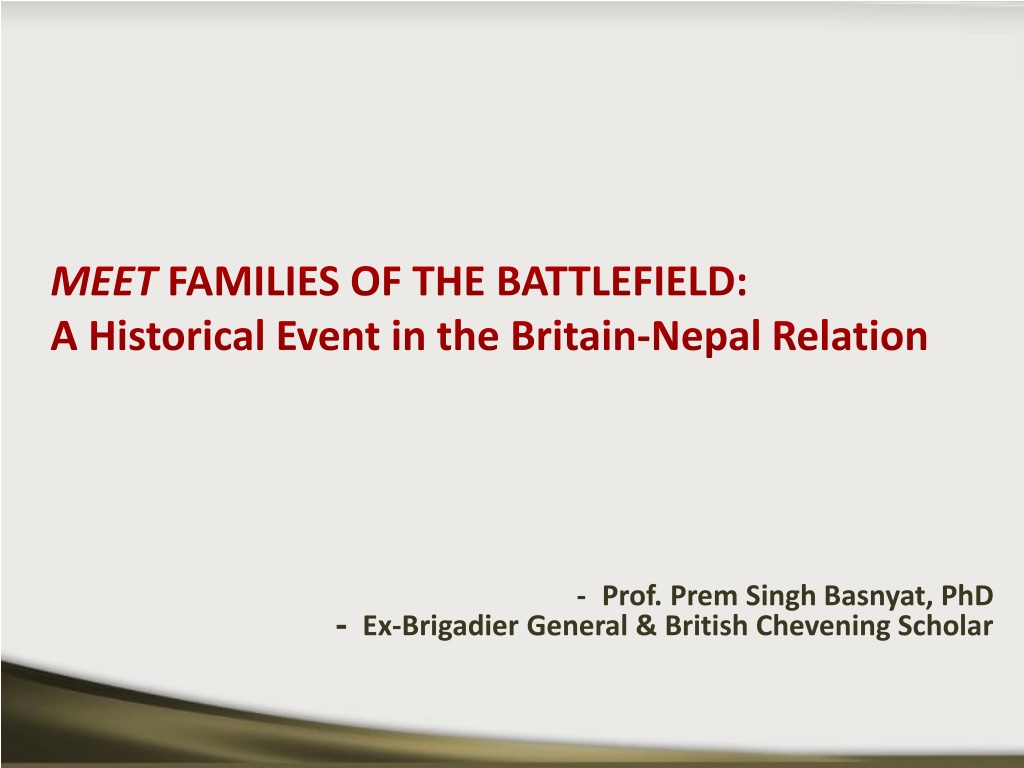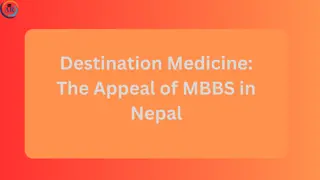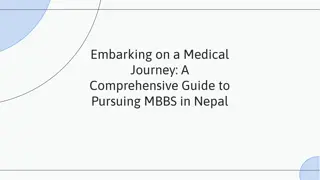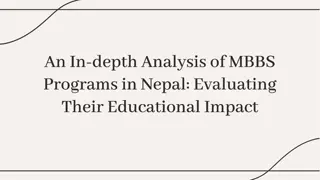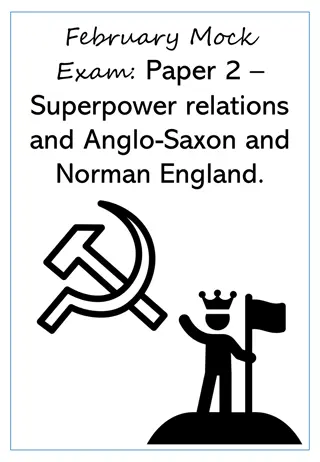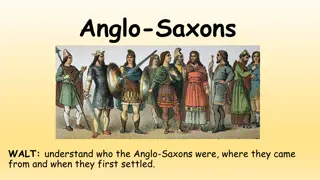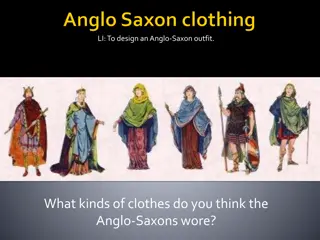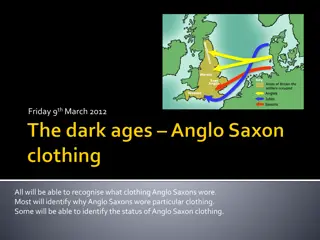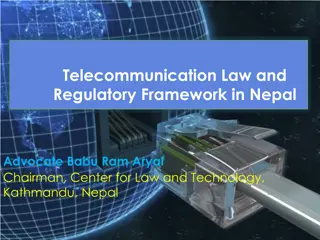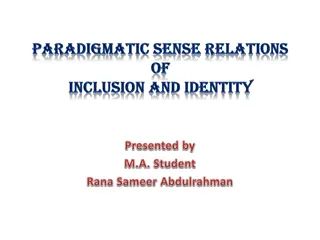Anglo-Nepal Relations: A Historical Perspective
Explore the historical events in the relationship between Britain and Nepal through the lens of Prof. Prem Singh Basnyat, tracing back to the beginnings of Anglo-Nepal physical relations and the Anglo-Nepal War. Discover the dynamics of power, conquest, and diplomacy that shaped the interactions between the two nations.
Download Presentation

Please find below an Image/Link to download the presentation.
The content on the website is provided AS IS for your information and personal use only. It may not be sold, licensed, or shared on other websites without obtaining consent from the author. Download presentation by click this link. If you encounter any issues during the download, it is possible that the publisher has removed the file from their server.
E N D
Presentation Transcript
MEET FAMILIES OF THE BATTLEFIELD: A Historical Event in the Britain-Nepal Relation - Prof. Prem Singh Basnyat, PhD - Ex-Brigadier General & British Chevening Scholar
BIGINING OF ANGLO-NEPAL PHYSICAL RELATION - Capuchin Padari in Nepal -Diplomatic mission of King Prithivi Narayan Shah -Battle of Sindhuli (Pauwa Gadhi) -Battle of Bagmati , near Hariharpur Gadhi -Gorkhali Military assistance to Kasi,Banaras- led by Kaji Kehar Singh Basnyat - Meeteri Saino -Anglo Nepal war - Agreement of Malaun Fort-1815 -Sugauli Treaty-1816
Before the Anglo-Nepal War, there was no more India and had more than 560 small states and principalities. The states used to fight against one another. After Prithvi Narayan Shah achieved success in his unification campaign in the east, his youngest son Bahadur Shah expanded Nepal up to Sutlej in the west. Similarly, the East India Company entered India in the course of its expansion of colonialism.
It hatched conspiracies to make the Indian states fight among themselves and used the troops against them to bring them under its control. The English were capturing the territory in the northeast while the Nepalese were expanding the territory to the southwest. Since the Nepalese had been ruling over places like Dehra Doon, Bilaspur, Sutlej, Kangada and Kumaon, the English appeared to be very soft and respectful towards the former in the beginning. The English were hatching conspiracies to expand their colonialism. It was because the English had experienced and heard about the consequences of the Gorkha troops and their bravery.
Ludhiana is about 266 miles northwest of Kathmandu. The English wanted to have good relations with Gorkhalis and to know their strengths and weaknesses. Nepalese rulers also wished to have better ties with the English. In such a situation, Bada Kaji Thapa and Col. Ochterlony had a meeting in Nepalese land with the coordination of the Nepalese and the English envoys. Similarly, the
As both the sides proposed to covert the meeting into a friendly relation, the friendly ties were established on November 11, 1813, Bada Kaji's son Ramdas and Col. (later Major General) David Ochterlony s son Ochterlony Junior became a an intimate friend (Meet in Nepalese language ) . This is a special bonded friendship forged through a ceremony or rituals to keep it lasting for generations. This relation always binds with the religious norms and values and very respectful in Nepalese culture. And the two military commanders were fathers of the close mates.
The straightforward Nepalese were unaware of the conspiracies and shrewdness of the English. From the foundation of the friendly relations, the English launched the Anglo-Nepal War in 1814 and created the history of the Sugauli Treaty in 1816. Thus, the friendship ties (Meeteri Saino) played an important role in Anglo-Nepal diplomatic history and older than the Treaty of Sugauli.
BEGINNING OF THE MEETERI SAINO Prior to Bhimsen Thapa, Bada Kaji Amar Singh was an army Commander-In-Chief and efficient courtier of the Nepal Palace and skillful governor. So, he was in a state of dilemma due to his self-esteem and the matter of having relations with the English. For organizing a friendly meeting, Ochterlony and his aides were more enthusiastic because the English knew that 'it would be impossible to fight against two separate enemies (Punjab and Nepal) at a time."
However, Col. Ochterlony himself was willing to meet Amar Singh, which would enhance the latter s pride. Thus, the Bada Kaji held an assembly of the courtiers and decided on the venue and agendas of the meeting. Taksar was fixed as the venue for the meeting. The place was one day's walk from Aarki Palace. It was one of Nepalese Bahra Thakurai states located in the Sutlej area. On November 11, 1813, Sardar Nirvaya Singh and Krishna Munsi were sent to Col. Ochterlony. They were also assigned to work as Nepalese envoys in order to bring the team of Ochterlony to Bada Kaji Amar Singh.
On November 9, 1813, Bada Kaji Amar Singh, along with his courtiers and troops, who were carrying some gifts, departed and stayed overnight at Baghat. On the next day, the Nepalese team reached Taksar and waited for Ochterlony to come. On November 10 of the same year, Ochterlony also left his residence at Ludhiana and stayed overnight at Panjor. As per the suggestions of Nepalese representatives Thapa, Munsi and English envoys Bargat Ali Khan and the approval of the two military leaders, the meeting point was fixed in- between Taksar and Panjor. Both the leaders had to walk one mile each and the venue was in Nepal s soil.
On November 10, leaving all his troops, logistics and courtiers in Panjor, Col. Ochterlony, along with his son Ochterlony Jr., Capt.Bhor Sahib, six elephants, 10 horses and some servants, headed to Taksar. Knowing all that, Amar Singh also left other troops and logistics at a rented house at Taksar. Together with his two sons Ramdas Thapa and Arjun Thapa, Laksha Bir Shahi, Rewant Kunwar and 120 troops, he moved for the destination. Bada Kaji Thapa and Col. Ochterlony had a meeting and exchanged greetings with each other.
Both sides started fulfilling formalities by praising each other. The clever English lauded Nepalese for their bravery. During the meeting, the political situation of Kangada, Punjab and other kingdoms were discussed and assessed. The Nepalese side clarified, by giving some examples that it did not act against the interest of the English. Bada Kaji Thapa clearly mentioned his intentions. The conclusion of the meeting between the two military leaders was that both of them would remain intimate friends and well-wishers of each other. The objective of the meeting was to let other local kings and kingdoms know the enhanced the Anglo-Nepal relations and have them frightened.
In order to enhance the relations as planned earlier, both the army commanders were to establish affable ties between their sons and exchange fabric turbans. As Arjun Thapa was more aggressive in nature, he was proposed to have friendly ties with junior Ochterlony. But they looked dissimilar in their age. So, the friendly relations were established between Ramdas Thapa and junior Ochterlony. In the afternoon of November 11, 1813, while changing the turbans, junior Ochterlony offered a shawl, kishap, a crown to be stuck to the turban, a piece of soft Varanasi silk piece, two handkerchiefs and one gold coin to Ramdas, while the latter presented one turban, shawl, kinkhap,kuchin, two fine cotton fabrics, gold coins and one Taji Ghoda (fast running horse) to the former.
After having established intimacy, Ramdas saluted Col. Ochterlony by offering one gold coin, while junior Ochterlony, who was also carrying a gold coin in his hand, was in a state of confusion. After a while junior Ochterlony held consultations with English envoy Bargat Ali Khan, who told Bada Kaji Amar Singh that since the English sahibs (masters) had yet to salute anybody, he (junior Ochterlony) shall salute his father by presenting the gold coin. Having heard that Col. Ochterlony said it was impossible as the Bada Kaji's son saluted him and junior Ochterlony must reciprocate. He also chided his son and got him to salute Amar Singh.
For a moment, Nepalese felt that the English were very arrogant. But terming the behaviours of his son and envoy Khan as immature, Col. Ochterlony resolved the problem tactfully. Then, Bada Kaji Amar Singh presented three sarbags (like deer-headed animal's tails), one live Kasturi (deer musk),nine Binas and 21 Chykhuras (partridges) to the English delegation. A sense of happiness was revealed that the Anglo-Nepal relations were strengthened again. As Col. Ochterlony was about to hand over some goods as presents to Bada Kaji Amar Singh, the latter refused to take them and said, "We won't take gifts as friendship is more than enough."
SELFISHNESS BEHIND FRIENDSHIP TIES There were many kings and Rajautas in the erstwhile India. They were involved in infighting and they did not have mutual understanding and harmony. By then, the Nepalese troops had captured Kumaon, Musuri, Nainital,Bilaspurand Kangada State, except the Kangada Fort, whereas the English troops, in course of its expansion of imperialism, was capturing the various principalities located in the periphery of Nepal. The English were strong in their troops, weapons and resources and the Nepalese were renowned in war techniques and bravery. Thus, they were like a snake and a scorpion. They did not want each other's intervention in fulfilling their interests. They did not want to fight against the two enemies at a time.
BADA KAJI AMAR SINGH'S FEELINGS After expanding Nepalese territory up to Sutlej and the Yamuna River, he was unable to advance further because of his continuous war in Kangada. King Samsara Chand was creating obstructions for the Nepalese to capture Kangada. In 1806, Bhimsen Thapa's younger brother Kaji Nayan Singh Thapa was killed as he tried to bring the Kangada fort under control. Then, Amar Singh Thapa kept on encircling the fort for four years. Despite that, Chand was adamant in his stance. During the unification battles, the Kangada fort was the palace of Sansar Chand, who was encircled by the Gorkha troops for four years.
BADA KAJI AMAR SINGH'S FEELINGS One day, Sansar Chand wrote a letter to Bada Kaji Thapa and requested him to grant him a period of 11 days for bringing his queen and residence out the fort. Thapa approved Chand s call and the latter took out his wife and the properties of his residence out of the fort. But one day, he, along with his bodyguards, secretly went out of the fort in women s dress and returned to it together with King of Punjab Ranjit Singh. Thus, knowing that Ranjit was there to help Chand, the Rajautas, who were not happy with Nepal and others who stood in favour of Sansar Chand, joined troops with Chand. In 1809, Sansar Chand, Ranjit and other Rajautas defeated the Nepalese troops. And the Kangada fort was under the control of Ranjit Singh. Deceived by Sansar Chand, Amar Singh wanted to re- assault the Kangada fort directly. For that, he needed the military help from powerful friend. He had thought that the English would extend their support to him. But the English did not have any intention to help Nepal and did not want to see the presence of the Nepalese in Sutlej and Kangada areas.
BADA KAJI AMAR SINGH'S FEELINGS With a view to attacking against the Kangada fort again, Amar Singh went to Panjor to meet Col. Ochterlony and sought the help. But Ochterlony said, "It is not good to launch any attack now. You can attack in the hilly regions wherever you like, but we do not extend any assistance to the Sikh (Maharaja Ranjit Singh) and you should not make assault in the plain land." Amar Singh mentioned it in his letter. Thus, Bada Kaji Thapa did not seem to have reaped any benefit from the friendship ties with the English.
COLONEL DAVID OCHTERLONY'S INTENTIONS English Col. David Ochterlony was very intelligent and man of soldiership. He had made significant achievement in the Anglo-Nepal War. He was famous for his lip service, but he used to deceive others in practice, but it is a war tactic. That means he would not do what he spoke. During 1812- 13, he had several enemies after defeating many Rajautas (rulers of principalities) in India. Those Rajauta sused to instigate the people against others and get involved in various terrorist activities by staying in Sutlej, Kumaon and Palpa areas. Some of the kings and Rajautas had recruited fighters and fought against the English troops and their supporters. During that time, even the weak states, which were not under the English control, would pose threats to the English. King of Punjab Ranjit Singh and Nepalese governor Bada Kaji Amar Singh were a source of threat for the English. Thus, the English wanted to contain the Nepalese threat.
COLONEL DAVID OCHTERLONY'S INTENTIONS Some nationalists, including Nawab of Rampur Gunla Mohammed Khan, Nawab of Ujareli Awadh Bajir Ali and King of Maisur Tipu Sultan, were defeated by the English. Then, they fled to Nepal. With the help of Nepalese, they wanted to take back their lost states from the English, who were well aware about it. Thus, cashing in on the friendship relations tied with Bada Kaji Amar Singh's son, Col. Ochterlony requested the governor of Palpa Chautara Bam Shah and the Kathmandu Palace through Amar Singh not to allow anyone to promote terrorism against the East India Company in the Nepalese soil.
COLONEL DAVID OCHTERLONY'S INTENTIONS In a letter addressed to the Government of Nepal, Ochterlony called for arresting and extraditing the kings and Rajautas, who would be against the English or submit their heads to him. The Government of Nepal also issued instructions to its authorities accordingly. Therefore, the English were expanding their colonialism fearlessly in India.
Besides, Ochterlony was well aware that the English had to fight against Nepal in the near future. They had already faced the consequences of the war techniques and bravery of the Nepalese. So, he was looking for a hole to enter Nepal in order to take stock of the actual situation of the Nepalese Army and get mixed up with the Nepalese people.
Bowing down before Bada Kaji Amar Singh through the friendship relations, he was able to open up the door to that end. Thus, the English took advantage of it. Comparing the friendship relations with others, it was a landmark event in Anglo - Nepal diplomatic history. The relationship is also responsible for limiting Nepalese boarder between the Mechi and the Mahakali Rivers. Nepal was great in terms of size following the unification campaign led by King Prithvi Narayan Shah, his daughter-in-law Rajendra Laxmi and youngest son Bahadur Shah and others.
The English were scared of the Gorkhali fighters as they were beaten up and chased away during the time of King Prithvi Narayan. They wanted to take revenge against Nepal. But it was not an easy task. It is impossible for one nation to take revenge against another nation without knowing the capabilities, behaviours and attitudes of its military troops. Anyway, the MEETERI SAINO helped the English to know Nepalese military strength and weaknesses.
